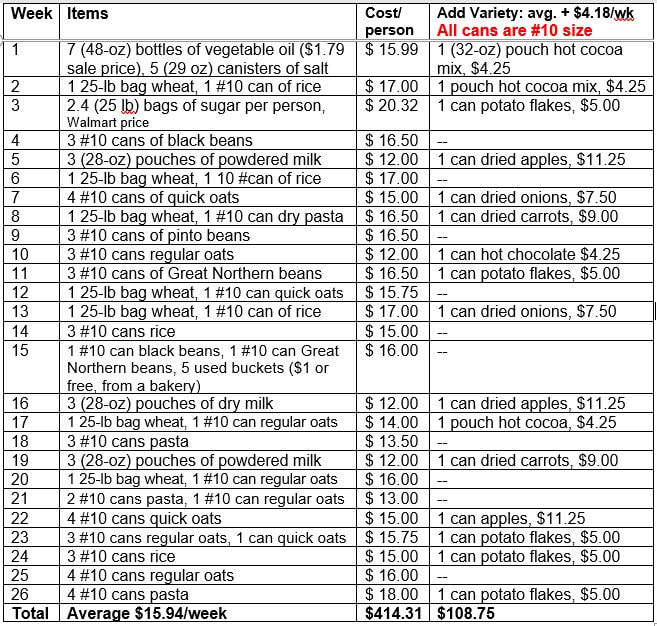Feel free to switch up the order of the weeks. For instance, whichever item is on sale that week, buy what you need of that one instead, then cross off items on your printed list as you get them. Use the savings to buy a ‘nice’ item there, a container of spices at the store, or accelerate your purchasing plan.
This year, at the prices in my area (the Wasatch Front in Utah), the basics will average you $15.94/week per adult (use the "Items" column only), or $4.18/week more for the plan with a little more variety (Use the "Items column, plus the "Variety" column).
*Neighbors and friends: if you have a special diet that requires you to stay away from wheat or powdered milk and need help finding affordable options, send me an email or text; I find deals on a regular basis.
Once you have the three month supply of everyday foods, how much will a year’s supply of food cost you? When you look at your monthly grocery bill, is it overwhelming to think of buying more? I recently looked an emergency supply store’s online catalog; they advertise a basic year’s supply of food for ‘just’ $1999, for a little over 2100 calories per day of the basics (plus a water barrel and hand-crank wheat grinder), or for the version with freeze-dried foods and more variety, $5,999. For one person. Is it really that much money to get a year’s supply?
Buying basics on your own from the Home Storage Center and local grocery stores costs about $414 for an adult for one year; a month’s worth of food for one person is about $33. (It cost $25.31 in 2011, $16.23 in 2010) This provides about 2200 calories a day.
The Home Storage Center Price List can be found here for purchasing in person, or here for ordering it online. Prices online include the shipping. (Please note that while the in-person order form doesn’t yet reflect this, the following items have been discontinued: berry drink mix, granola, instant complete potatoes, instant refried beans.)
These are the basics:
Grains- 300 pounds Dry milk- 16 pounds
Sugar- 60 pounds Salt- 8 pounds
Legumes- 60 pounds Oil- 10 quarts
If you’re storing food for children, plan on
50% of these amounts for age 3 and under,
70% for ages 3-6, 90% for ages 7-10, and
100% for ages 11 and up.
Or store as much as you would for an adult and have enough to share.
Here is the cost breakdown for one adult:
Grains, 300 lbs- $22.08 per month, $265 per year. Costs were based on 150 lbs of wheat (28 cans) 100 lbs of rice (18 cans), and 50 lbs of oats (20 cans-- 10 quick oats, 10 regular oats). For a little bit more money, you can get some of your grains in the form of spaghetti or macaroni, which are also sold at the Home Storage Center. I’ve recently seen local wheat sell for $15 per 50 lb bag; buying your wheat that way would knock the cost down $50. Spend that on the nice extras, listed at the end of this list!
Milk, 16 lbs -- $3.00 per month, $30.24 per year. (9 pouches) Any evaporated milk you store counts towards this, too; it takes 5 1/2 (12 oz) cans of evaporated milk to equal one pound of dry milk powder. (Both of those amounts will reconstitute to one gallon.)
Sugar, 60 lbs. $1.69 per month, $20.32 per year. The cheapest way I've found is to buy it in 25 lb bags, which are $8.22 at Walmart now. It’s sometimes that price at other stores on sale. You’ll need (3) 5-gallon buckets to store it in, which you can pick up used at many bakeries for about $1 each. (Bakeries get their frostings and fillings in 2.5 and 5-gallon buckets.) Brown sugar, powdered sugar, and honey count towards the total.
Oil, 10 qts –$1.02 per month, $12.29 per year. This isn’t sold at the home storage center, but the last good sale price I found for canola oil was $1.79 for 1 ½ quarts (48 oz.)
Salt, 8 lbs- $.33 per month, $3 per year. 26 oz of store brand salt is $ .59. You’d need 5 of them, for $3.03 after tax. 4# box at Sam’s Club is $1.46, total for 8 lbs is $3.01.
Legumes, 60 lbs– $5.04 a month, $60.50 per year. (11 cans) The home storage center sells black beans, pinto, and white beans. They also sell dehydrated refried ones, for about twice the price. (These have only a 5-year shelf life, versus 30 years for the regular beans. But they’re very convenient.)
Water, 14/gal/person- You can store this for free by using 2- and 3- liter pop bottles, or juice containers (not milk jugs- they break down). Or use the 5-gallon square jugs or big blue barrels; they’ll run you about $1 per gallon of storage.
For about $110 more you can get the following:
-2 (#10) cans of dried onions- the #10 can holds 12 ¾ cups-- the equivalent of almost 70 medium onions (3 Tbsp dried onion = 1 medium fresh onion), without the tears and chopping. They can even be reconstituted and grilled or caramelized! (2 cans =$15)
-3 (#10) Apple slices (3 cans = $33.75)
-6 (#10) cans of potato flakes (6 cans = $30)
-2 (#10) cans of dehydrated diced carrots, equivalent to about 10 pounds of fresh carrots, nicely diced for you. (2 cans = $17.00)
-4 (1-lb) bottles of honey ($16) or four 2-lb packages of hot cocoa mix-- each package makes about 32 8-oz servings or two gallons. (4 packages = $17)
Other things you might consider getting at the home storage center:
Water bottle with filter ($15), pancake mix, potato flakes, more pasta or anything else.






 RSS Feed
RSS Feed